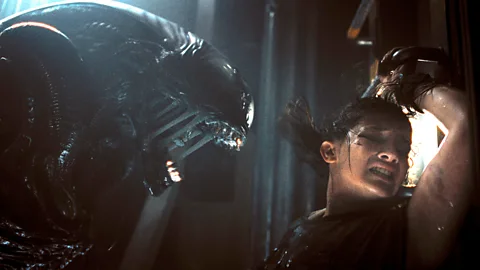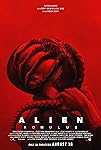Eye For Film >> Movies >> Alien: Romulus (2024) Film Review
Alien: Romulus
Reviewed by: Andrew Robertson

I started this review in a fashion that seemed appropriate. In the roar of air conditioning, the crackle of headphones, the rattle of old roads and a late night bus. The laptop an older piece one held together with electrical tape and software itself is out of date, possibly older than some of the other passengers. Much like another return to a foundational science fictional text, The Force Awakens, I was thinking about the film before I had seen it and writing then too.
The faded technical aesthetic that is one of the keys to unlocking Alien's haunted house isn't unique to that film or that franchise. Other work by Ridley Scott maintains that sense of futures gone to seed, of the ripple of kipple, a tide of weather and wear across the sands of time. While works like Prometheus attempted to marry newer visions and ways of seeing to a vibe, a feeling, I don't think they succeeded, indeed the closest filmic tone that came to repeating was not its own ur-text but that of Dune, the elements of Lawrence Of Arabia decayed to produce something new if not harmful.

Having seen it now, and writing on a different, even later, bus I find myself conflicted. I think it fair to have written most of the two preceding paragraphs beforehand because they're about weight of expectation, what has gone before. Film has a habit of trailing genres behind it, categories formed in the wake of successes. These are often stories or forms thereof that have been previously told but reach a certain point that's thereafter associated with them. Alien is one, even if it's a subset of the monster movie. Your Rashomon, your John Wick, and among them what I would call a Skyfall. A new story within a franchise that is a love letter to the highlights, a sampling of previous bits and bobs and beats that's something new from what has gone before.
Correspondingly there's a Spectre, where rather than take old ingredients and make them fresh, leftovers are thrown together and reheated. Alien: Romulus feels far more of the latter. When constructing a collage there is a responsibility to be curatorial. That Romulus appears so willing to recreate even from the smallest parts would be sad enough if there weren't already a warning within the franchise. The fourth of what marketing still insists is called a 'Quadrilogy' when 'Tetralogy' had amongst its teratology a hybrid that is still regarded as a low point. That five dollar word for monster science is about four bucks more clever than the film, which seems less intent on subtle reminders than plundering remainders.
That its central plot is an attempt at salvage is perhaps an irony, that it goes not unexpectedly awry doubly so. To think of other franchises with unkempt spaceships Romulus is more of Solo than Rogue One, though in its attempt to tell a story between other films it does borrow one key element. Among the things returned to life a new science officer, Rook, nominatively kin to Lance Henriksen's Bishop and twin to Alien's Ash. Literally, if not technically so, a performance by potentially familiar face Daniel Betts re-skinned with archive footage much as Princess Leia was rejuvenated on that Tantive IV before. It feels off. There's the uncanny valley, later thanks to the estate sure, but the fact that this has been done before changes the nature of the damage.
It's far from the only thing that makes me uneasy about Romulus. There's been pre-release discussion of practical effects. There are undoubtedly some, but to suggest that there's no computer graphics is a disservice to the nine or more digital firms in the credits. There are scenes that may have involved reference models that exist in reality but there's no way on or above some of the scenes where things crash into other things while other things are still crashing into them in the background were achieved in camera. I say that as someone who adores Fury Road, which is similarly described as CG free. If nothing else there's plenty of ropes and wires removed, as outside Apollo 13 I don't think anyone has the budget or bravery to use actual microgravity. It might be called free fall, but it's far from cheap. Above and beyond the pure pixel wranglers are institutions like Weta or the Tippet (as in Phil of Mad God animation studios who will use machines for various purposes. There's plenty of actual machines, including the distinctive Sherp all terrain vehicle.
I assume someone in the space station procurement bureau of Weyland-Yutani had a Key Performance Indicator or kickback preference for integrating multiple transport systems into the eponymous station. Or rather both halves of it, as the suspiciously abandoned Romulus station is attached to an identically neglected Remus station. The notion of two-facedness is perhaps more appropriate than seeking succour from wolves, as the twins of the seven hills did alright for themselves. As did, one assumes, whoever signed off on a station that contains a conveyor belt, mechanical lifts, escalators that appear to have been lifted straight out a tube station, a cable car, some more of those Sherps, a couple of different air-locks and just enough different kinds of corridors that it's only when they're jarringly differently lit between shots that you realise how few of them there are.
Director Fede Alvarez co-writes with frequent collaborator Rodo Sayagues. They've perhaps best known for remake/reboot Evil Dead, and this too has some first-person monster moments. There are a couple of very gangly gentlemen portraying the xenomorphs or other relatives but what's most stretched here is not disbelief but the material.
There's a moment that's lifted from a deleted scene from Aliens that was restored to a special edition. It's a shot that counts, cyclically. I noticed it, thought about the previous version, saw it resolve in a similar fashion and continued to wait. I shan't list the moments lifted from the other films within the franchise, but there are some from all of them. Yes, even that one. Some of them are presented in a somewhat clever way, but some are forced, unearned, payoff for setup that isn't here. There's loads of incident, but so much of it is lifted from other parts of the series that what little is original doesn't feel that new. One sequence reminded me of Star Trek VI: The Undiscovered Country, though the Pepto Bismol was replaced with pea soup. That constant cycle of repeated events means that there isn't time to digest much, just to jump in familiar ways.
A section with new directives has shades of Robocop though the presence of synthetics does give some room for thought. As in Blade Runner 2049, corporate interests are made corporeal with drastic effects. Those electric sheep make one wonder if Jones in the first was real, and what it would mean that Ripley went back for him. Here we've a canary on its way to a coal mine, and I'm not sure what allusions are being made. There's precedent to believe we'll eventually get a documentary and a director's commentary to fix it all, though again and again Ridley Scott's work has warnings within and of the text about revisiting past creations.
There are also references within Benjamin Wallfisch' score to previous ones, including themes written by Chris Goldsmith and James Horner. There's also a good chunk of Wagner's Rheingold, specifically The Entry Of The Gods Into Valhalla. One wonders if there had been a hope to use Norse myth to source the station's name. Freyr and Freyja give you wealth, harvest, fertility and war, but perhaps also invite brand confusion with other Disney properties. The plundering is somewhat constrained as well by an absence of Predators, however brave those involved might feel about rehabilitating elements of the franchise it's got sense enough to avoid losing battles. The 20th Century Studios title is interrupted and refocused, not pixels but phosphor dots, a cathode-ray across the bows. The font over the opening credits replicates the vague blur of back-projection and LetraSet, the artefacts of an era reconstructed by modern means. That fuzziness makes crispness in other places all the more noticeable, like fresh acid-free paper spliced into aged vellum. Vellum is made of animal skin.
There are other nods in production design to Blade Runner, I caught a particular purge screen with its air of BBC Micros and Teletext. Ron Cobb's Semiotic Standard gets a run-out too, and the Weyland-Yutani logo (with that spelling) appears everywhere. There are smokers on screen, events are pretending to be the past, so that's natural, but the cast look so young that even this feels off. Cailee Spenny and David Jonsson are highlights in a relatively small group, though almost everyone gets a chance to do some running and jumping and falling down, with degrees of terror to taste.
There are some bits that I found both noteworthy and good. There's a new stage in the traditional xenomorph life-cycle depicted, and I think in his memory Giger would be pleased at the fresh obscenities it conjures. There are other elements around bodily autonomy and pregnancy that I think would be distressing in ways the film does not intend. There's some other stuff that I think should see Neil Blomkamp asking for royalties, if not royal jelly. It does a reasonable job of setting up its components though a moment with a fire-extinguisher reminded me variously of James Cameron's Avatar: The Way Of Water in terms of its convenience.
In the opening sequence we're shown a relief carving of a xenomorph. Such a thing could be used as a mould, but the film is so intent on replication that it doesn't break it, or free. The expanded universe suggests that the perfect organism takes what it needs from its host to create something efficient, sleek. Alien: Romulus is neither. Think of a moment from the franchise and you will find its echo here. So full of borrowings is Alien: Romulus that there isn't room to hear you scream. Perhaps the most indicative is the name of this ship, taking its name from another character in Joseph Conrad's Nostromo. Father Corbelan gives his name to the short range cargo hauler. We'll gloss over the priestly and paternal aspect and focus on the latter part. Its etymology is from 'basket', and it'd be unkind to call this a -case, but it isn't as well woven as one would hope.
Reviewed on: 16 Aug 2024



















